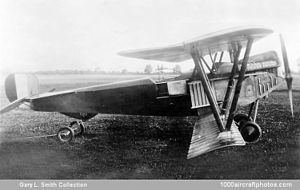Top speed 155 km/h | Wingspan 17 m | |
 | ||
The Nieuport 15 was designed as a bomber aircraft during World War I. Due to disappointing performance the type was rejected and never entered service.
Contents
Design and development
Based on the Nieuport 14, the new bomber was built in the summer of 1916 and the first prototype was ready for testing in November of that year.
The Nieuport 15 was a twin bay un-staggered wing sequiplane with V-struts and a newly designed tailplane including heart shaped elevators. It was powered by a 220 hp (160 kW) Renault 12F V-12 engine. featuring Hazet vertical tube radiators.
During limited flight testing the controls and landing gear were found to be unsatisfactory and the French quickly abandoned the bomber type. Late in December 1916 it was declared obsolete. The British showed some interest and initially ordered 70 aircraft but after disappointing tests all orders were eventually cancelled.
Specifications
Data from History of War
General characteristics
Performance
Armament
